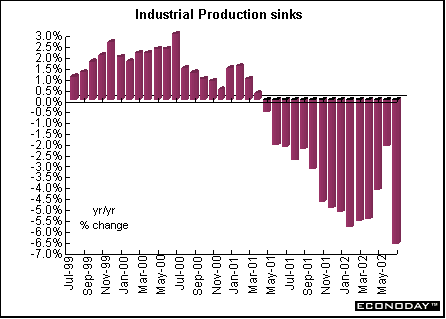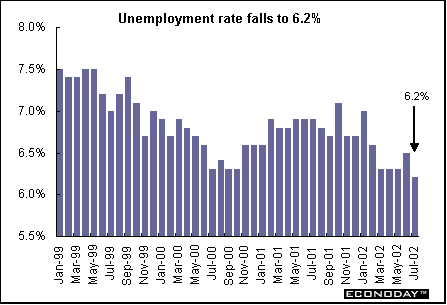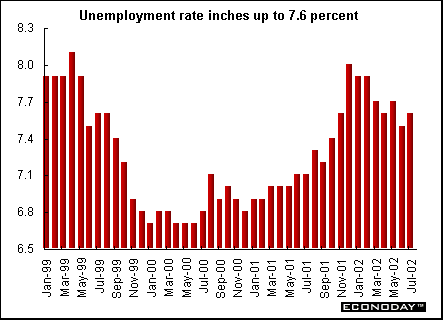
Indicator scoreboard
EMU - June seasonally adjusted unemployment rate rose to 8.4 percent from 8.3 percent in May. Spain continued to have the highest unemployment rate - 11.5 percent, followed by France (9.2 percent), Finland (8.9 percent), Germany (8.3 percent) and Belgium (6.9 percent). Luxembourg had the lowest unemployment rate (2.3 percent), followed by Austria (4.1 percent) and Ireland and Portugal (both at 4.4 percent).

July seasonally adjusted Reuters purchasing managers' services activity index was 52.6, down from 53.0 in June. An index reading that is above 50 signals that activity is expanding, a reading below 50 that it is contracting. The higher the reading is above 50, the faster the expansion.
First quarter real gross domestic product was unrevised at 0.3 percent both on the quarter and when compared with last year. Gross fixed capital formation growth was revised down to a drop of 0.5 percent on the quarter from the originally estimated decline of 0.1 percent. Export growth was revised up to an increase of 0.8 percent from 0.5 percent and imports were revised to a decline of 0.6 percent from the originally estimated decline of 0.8 percent. Growth in household consumption, government consumption and domestic demand were unrevised.

Germany - June seasonally adjusted merchandise trade surplus was €9.8 billion, down from a €10.4 billion surplus in May but up from a €6.8 billion surplus in June 2001. Exports were up 7.2 percent and 3.8 percent when compared with last year. Imports were up 10.5 percent but are down 2.2 percent on the year.
July seasonally adjusted unemployment rose by 8,000. A combination of continued economic weakness and seasonal factors mainly related to school holidays boosted the seasonally adjusted unemployment rate to 9.9 percent from 9.8 percent in June. The unemployment rate rose to 7.9 percent in the west and slipped to 18.3 percent in the east.

June seasonally adjusted industrial production rose 1.7 percent but declined by 2.3 percent when compared with last year. Industrial output bounced back after being dampened considerably in May by strike action and the large number of holidays. Excluding construction, pan-German industrial output rose 1.7 percent after falling 1.3 percent in May. Capital goods output rose 3.4 percent after falling 3.1 percent in May. West German industrial output rose 1.8 percent after dropping 1.7 percent in May. East German production rose 1.2 percent after sinking 0.9 percent in May.

Italy - June seasonally and workday adjusted industrial production dropped 0.9 percent and 1.7 percent when compared with last year. Consumer goods' output fell 1.8 percent and investment goods dropped 2.2 percent while intermediate goods shed 0.4 percent.
Second-quarter preliminary gross domestic product edged up 0.2 percent from the previous quarter and on the year. First-quarter growth was revised down to an increase of 0.1 percent and was unchanged when compared with last year.
Britain - July seasonally adjusted Halifax house price index rose 1.9 percent and 20.8 percent when compared with last year. The price upsurge is being driven by a continued shortage of properties.

June global merchandise trade deficit rose to £3.048 billion from £1.801 billion in May. National Statistics said the timing of the Jubilee holiday this year, when some firms closed for up to a week, makes interpretation of monthly movements difficult. They warned that the June deficit was probably distorted upwards. The Jubilee holiday and the staging of the World Cup football tournament in June have played havoc with data releases, making it difficult to gauge the underlying strength of the economy. The value of global goods exports plunged 12.9 percent after rising 5.4 percent in May, and imports were down by 5.1 percent after a 1.6 percent increase in the previous month. Exports volumes fell 14.1 percent and imports fell 5.6 percent. Excluding oil and erratic items the global trade gap widened to £3.216 billion from £2.042 previously.
June industrial output dropped 4.3 percent and 6.6 percent on the year. Manufacturing output fell 5.3 percent and 8.3 percent when compared with last year. The monthly fall in manufacturing output was last greater in January 1979, when output fell 9.6 percent on the month. Again, National Statistics warned that caution should be exercised in interpreting the recent monthly changes due to the Jubilee bank holiday.

July Chartered Institute of Purchasing and Supply service activity index eased to 54.7, down from 54.9 in June but still well above the key 50 contraction/expansion level. The overall optimism index had been hit by the financial services sector, which has been most directly exposed to the recent financial market turmoil.
Asia
Australia - July seasonally adjusted unemployment rose by 28,300 jobs. However, the unemployment rate came in at 6.2 percent, the lowest since October 2000 and down from 6.5 percent because fewer people looked for work. Full time jobs declined by 17,900 and part time jobs fell by 10,500 positions. The drop in jobs follows the creation of 12,600 new positions in June. July was only the second month this year the economy has lost jobs. Australia has added some 110,000 jobs this year. The participation rate, which measures the number of people in work or seeking jobs, fell to 63.3 percent from 63.7 percent a month earlier.

Americas
Canada - July employment rose by 23,000 jobs, bringing employment growth to 326,000 since January. However, more people sought work, therefore the unemployment rate edged up to 7.6 percent. The participation rate jumped a full percentage point to 66.8 percent. Employment growth was in full-time jobs, up 35,600, while part-time employment edged down by 12,600. The goods-producing sector gained 29,700 jobs and the service-producing sector lost 6,600 jobs.



Last Week's Highlights • Global
Stock Market Indexes • Recap of Global Markets
• Currencies • Indicator
Scoreboard

The Bottom Line •
Looking Ahead
|